Capetown to Rio 2000 in a Norseman 43
"And don't come below until you've sailed 35 miles." With that instruction we left Richard and Pat to their watch. A few minutes later a "Yeeessss 18.2!" from the wheel implied that Richard didn't want to stay on deck long. But it wasn't easy staying below at that speed as the bow waves were hitting the bridgedeck right under the saloon, so leaving Dennis to make teas all round I went back on deck. The threatening squall had arrived, it was raining now and we were close reaching in 22 knots of apparent wind. Full oilskins, hat, fleece jacket and boots. Was this really midsummer in the South Atlantic?
Quite a contrast from the start off Capetown on January 8th. A hot and sunny flat calm greeted the 80 boats starting the first ocean race of the new century - the MTN sponsored Cape to Rio Race. Even the big American Maxis struggled to get clear of the spectator fleet, but eventually Zephyrus, Sagamore and the rest got away into the clear wind, never to be seen again. The St Francis 44 Galileo sailed by its builder Duncan Lethbridge showed its form early by being the first catamaran to get clear. A few others followed but 35 boats were left becalmed between Robbin Island and Table Mountain until dusk. But calms never last for ever and eventually the whole fleet got away heading north up the African coast hoping to cut across towards the SE trades the next day.
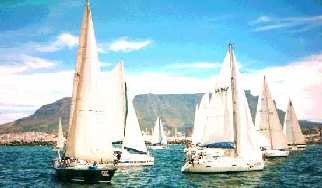
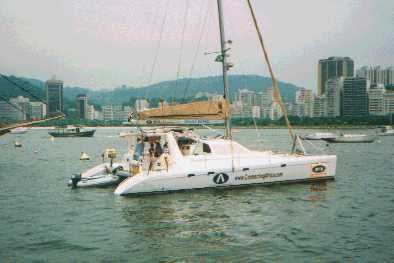
A day we will never forget. Before the kettle had boiled the rain stopped and within seconds the wind started to pick up. "Time to reef" says I. If you think it's time to reef then it is. Wrong, you should reef before you think you should. Instead of the boat accelerating, the bows dug in and went down, and down, and doowwnn. The boat slowed, so the apparent wind became true wind. Richard saw 46 knots as the boat came to a halt with both rudders out of the water and the mast step underwater. Meantime Dennis was desperately trying to catch every thing in the galley, while Eric, asleep in his bunk, was thrown forward into the cabin bulkhead. Slowly, so slowly the bows reappeared, but by then Pat and I were fighting to get sail off. Big fully battened sails are awkward beasts to reef when the wind is aft but adrenaline (pronounced panic) made it easier. But my ribs were sore for days afterwards as I crashed into the mast in my efforts to get the main down. As the squall passed the wind went round further, but it wasn't until a couple of hours later that we dared hoist the (small) spinnaker. It was final proof to me that you should never sail offshore in a boat with fine bows, no reserve buoyancy and no dynamic lift. But our dramas were nothing compared to those occurring elsewhere in the fleet. During our radio sched the next morning someone broke in with "Mayday, Mayday this is La Bamba, we've hit a container, are holed and flooding". Quite a good way to get attention! La Bamba's crew managed to keep their boat afloat until the next morning when the crew of Island Fling an Island Spirit catamaran picked them up. Useful things catamarans, every monohull sailor should have one in tow! With 3000 miles to sail and 12 people now on board, Island Fling diverted to Namibia where all arrived safe a few days later.
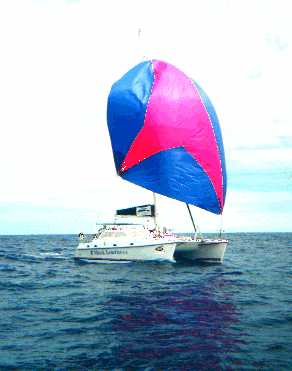

Still we battled north and west until, at last, when we were firmly in the tropics, it began to warm up and we didn't need English Channel clothing at night. With so little wind the sea had flattened and I agreed with Dennis that he could sail even his Laser across the Atlantic, never mind his Strider. Then we had another memorable day. It started with 3 boats in sight and a ship motoring past - the first we'd seen for nearly 3 weeks. Then the wind died completely and in mid afternoon we all went for a swim round the boat. That's when I realised how low the bridgedeck was. No wonder it slammed so much.
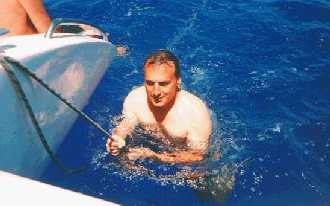

Now it was 800 miles to the finish and it seemed we were on the home straight, but we still had the worry about the time limit and flights home. Should we retire now or carry on? Our spreadsheet still said we'd just make it. At last the coast of Brazil came in sight and we slowly beat down towards Rio. It was now Feb 3rd and we still had 120 miles to go. But we weren't the only ones still racing. Out to sea we could see a sail - was it the boat that passed just ahead of us in the night? Just behind was "Geriatrics" and ahead was "Slobro" with "Brokenwing" hull down ahead. A proper race at last! Inexplicably Slobro tacked inshore, clearly following the scenic route, fell into a hole and was left for dead. Approaching Rio was dramatic, the famous Sugar Loaf mountain was clearly visible, as was the statue of Christ. But the wind was dropping all the time. At 6pm when we were 10 miles out we radioed in our ETA as 10pm.. Slowly we drifted on under spinnaker. Surely we'd make it before dark? But at dusk the tide turned and the wind completely disappeared. 4 miles to go. At midnight we still had 2 miles to go.
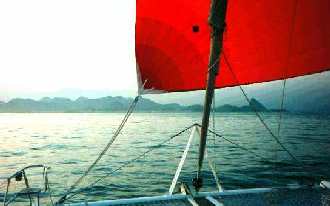
Then we heard on the VHF "left for dead Slobro" calling race control to say they'd be finishing in half an hour. Well they hadn't passed us yet so clearly something was up. Suddenly we saw a light out to sea, quickly gybed the spinnaker in anticipation of the new wind and the race was on. And what a race, drifting at 1 knot (gasp!), sometimes 11/2(Wow!), hand holding the clews of the spinnaker as the sheets were too heavy, the lights of Copacabana beach getting closer all the time and Slobro only 10 yards away. Frantic calls on the VHF "where's the finish line?", a photolaunch blinding us with his flash until at last we cross the line, just a boatlength behind Slobro at 1.03am Feb 4th, just 9 hours inside the time limit and last official finisher. Motor round to the club, past the beach and Sugar Loaf mountain with a floodlit Christ statue apparently suspended from the sky. That's Brazil, been there, seen it, got the tee shirt. Less than 36 hours later I was back in the UK. Post script: We took 26 1/2 days to cover 4150 miles and came 4th in class. Zephyrus had finished 15 days earlier...as I say, never mind the results - except that a Woods 40 won the multihull cruiser class and 25 boats failed to finish in the time limit.









